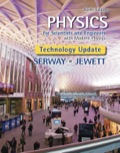
Concept explainers
(a)
The Q value of the decay of
(a)
Answer to Problem 19P
The Q value of the decay reaction is
Explanation of Solution
The
Write the formula for the Q value of the above decay reaction.
Here,
Conclusion:
Substitute
The Q value of the decay reaction is
(b)
The total kinetic energy shared by the proton and the
(b)
Answer to Problem 19P
The kinetic energy of the products is
Explanation of Solution
The Q value is the difference in the kinetic energy of the reactants and the products. The kinetic energy of the reactant is zero, thus the kinetic energy of the products will be equal to the Q value of the reaction.
From section (a) the Q value of the reaction is
Conclusion:
The kinetic energy of the products is
(c)
The total momentum shared by the proton and the
(c)
Answer to Problem 19P
The total momentum shared by the proton and the
Explanation of Solution
The
Thus the total momentum shared by the proton and the
Conclusion:
The total momentum shared by the proton and the
(d)
Whether the proton and the
(d)
Answer to Problem 19P
The
Explanation of Solution
The momentum of the proton and
Write the formula for the kinetic energy of the proton.
Here,
Write the formula for the kinetic energy of the
Here,
The sum of kinetic energy of the proton and
Solve the above equation.
Substitute
Substitute
Substitute
Thus the
Conclusion:
The
Want to see more full solutions like this?
Chapter 46 Solutions
Physics for Scientists and Engineers with Modern Physics Technology Update
- The electrical power output of a large nuclear reactor facility is 900 MW. It has a 35.0% efficiency in converting nuclear power to electrical. (a) What is the thermal nuclear power output in megawatts? (b) How many 235U nuclei fission each second, assuming the average fission produces 200 MeV? (c) What mass of 235U is fissioned in one year of fullpower operation?arrow_forwardIf 1.01030MeV of energy is released in the annihilation of a sphere of matter and antimatter, and the spheres are equal mass, what are the masses of the spheres?arrow_forwardIntegrated Concepts The primary decay mode for the negative pion is (a) What is the energy release in MeV in this decay? (b) Using conservation of momentum, how much energy does each of the decay products receive, given the is at rest when it decays? You may assume the muon antineutrino is massless and has momentum just like a photon.arrow_forward
- Unreasonable Results A particle physicist discovers a neutral particle with a mass at 2.02733 u that he assumes is two neutrons bound together. (a) Find the binding energy. (b) What is unreasonable about this result? (c) What assumptions are unreasonable or inconsistent?arrow_forwardDerive an approximate relationship between the energy of (decay and halflife using the following data. It may be useful to graph the leg t1/2 against Ea to find some straightline relationship. Table 31.3 Energy and HalfLife for (Decay Nuclide E( (MeV) t1/2 216Ra 9.5 0.18 (s 194Po 7.0 0.7 s 240Cm 6.4 27 d 226Ra 4.91 1600 y 232Th 4.1 1.41010yarrow_forward(a) Calculate the energy released in the a decay of 238U. (b) What fraction of the mass at a single 238U is destroyed in the decay? The mass of 234Th is 234.043593 u. (c) Although the fractional mass loss is laws for a single nucleus, it is difficult to observe for an entire macroscopic sample of uranium. Why is this?arrow_forward
- (a) Write the complete a decay equation for 226Ra. (b) Find the energy released in the decay.arrow_forward(a) Write the decay equation for the decay of 235U. (b) What energy is released in this decay? The mass of the daughter nuclide is 231.036298 u. (c) Assuming the residual nucleus is formed in its ground state, how much energy goes to the particle?arrow_forwardThe electrical power output of a large nuclear reactor facility is 900 MW. It has a 35.0% efficiency in converting nuclear power to electrical power. What is the thermal nuclear power output in megawatts? How many 235U nuclei fission each second, assuming the average fission produces 200 MeV? What mass of 235U is fissioned in 1 year of full-power operation?arrow_forward
- Integrated Concepts Suppose you are designing a proton decay experiment and you can detect 50 percent of the proton decays in a tank of water. (a) How many kilograms of water would you need to see one decay per month, assuming a lifetime of 1031 y? (b) How many cubic meters of water is this? (c) If the actual lifetime is 1033 y, how long would you have to wait on an average to see a single proton decay?arrow_forwardThe primary decay mode for the negative pion is What is the energy release in MeV in this decay?arrow_forwardWhat lifetime do you expect for an antineutron isolated from normal matter?arrow_forward
 Modern PhysicsPhysicsISBN:9781111794378Author:Raymond A. Serway, Clement J. Moses, Curt A. MoyerPublisher:Cengage Learning
Modern PhysicsPhysicsISBN:9781111794378Author:Raymond A. Serway, Clement J. Moses, Curt A. MoyerPublisher:Cengage Learning Principles of Physics: A Calculus-Based TextPhysicsISBN:9781133104261Author:Raymond A. Serway, John W. JewettPublisher:Cengage Learning
Principles of Physics: A Calculus-Based TextPhysicsISBN:9781133104261Author:Raymond A. Serway, John W. JewettPublisher:Cengage Learning College PhysicsPhysicsISBN:9781938168000Author:Paul Peter Urone, Roger HinrichsPublisher:OpenStax College
College PhysicsPhysicsISBN:9781938168000Author:Paul Peter Urone, Roger HinrichsPublisher:OpenStax College University Physics Volume 3PhysicsISBN:9781938168185Author:William Moebs, Jeff SannyPublisher:OpenStax
University Physics Volume 3PhysicsISBN:9781938168185Author:William Moebs, Jeff SannyPublisher:OpenStax College PhysicsPhysicsISBN:9781285737027Author:Raymond A. Serway, Chris VuillePublisher:Cengage Learning
College PhysicsPhysicsISBN:9781285737027Author:Raymond A. Serway, Chris VuillePublisher:Cengage Learning




